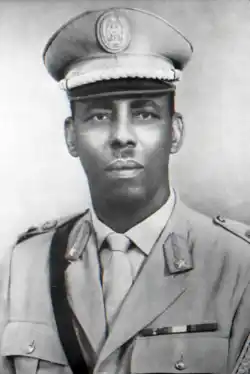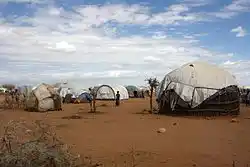The Somali Civil War is a conflict which in one form or another has raged in Somalia since the late 1980s. It is still underway today three and a half decades later and is one of the longest running conflicts of modern times. It ostensibly began as a movement to remove the Somali dictator, Mohammed Siad Barre, from power. Once this was accomplished in 1991, an even more damaging civil war commenced. The most intense period of fighting then occurred across the early to mid-1990s. From 1997 onwards efforts were underway domestically and internationally to transition to a peacetime government. However, while some progress has been made over the years, Somalia remains a deeply divided country, with the government controlling some regions and Islamic groups such as Al-Shabaab ruling other sections of the state. Millions of people have been displaced owing to the fighting over the years, many internally within Somalia and others abroad, principally to Ethiopia, Kenya, Uganda and Yemen.[1]
Research your ancestors on MyHeritage
Somali Civil War chronology of eventsSomali Civil War chronology of events

The coastal regions of the Horn of Africa were coveted by several European powers in the late nineteenth century during the Scramble for Africa and the French, British and Italians all ended up with colonies here by the dawn of the twentieth century. Italy eventually acquired the more dominant position. Owing to its role in the Second World War amongst the Axis Powers, Somaliland was largely placed under joint British, Italian and United Nations rule from 1945 onwards before being granted independence as Somalia in 1960. As with the vast majority of post-colonial African states, an experiment in stable democracy after independence proved short-lived and in 1969 Mohammed Siad Barre seized power in a largely bloodless coup. He ruled the country for the next twenty-one and a half years. Discontent with his rule intensified in the 1980s, leading to government clashes with various rebel groups in what might be considered the beginning of the Somali Civil War around 1988. This first phase of the conflict culminated in the fall from power of Barre at the start of 1991.[2]
Barre’s removal from power did not solve the crisis within Somalia. Instead the new power vacuum led to an intensification of the violence in the early to mid-1990s, compounded by the development of famine conditions in 1992. There were many different entities involved in this, most notably the Somalia National Front, while United Nations peacekeeping forces were also present on the ground from the late spring of 1992 onwards. For a time thereafter Somalia became a failed state, without anything resembling a central government able to enforce control over a substantial part of the country. It was only from 1997 onwards that some temporary stability was re-established and the Somalia National Front acquired international approval to establish a transitional government into the early 2000s.[3]
After a period of some progress, the violence intensified again in 2005 as Somalia became a new front in the clashes between Islamic extremism and western-backed governments. Efforts to destroy the Islamic Courts Union, an Islamic group determined to impose Sharia law in Somalia, led to the invasion of the country by Ethiopia in 2006 and the Battle of Mogadishu in March and April 2007, when Ethiopian and Ugandan troops helped the transitional government to secure the city from Islamists like the nascent Al-Shabaab, a terrorist-military force aligned with Al-Qaeda.[4]
Since then the war has oscillated over time, with groups like Al-Shabaab continuing to control large parts of the south of the country and the government and its international allies controlling Mogadishu and the north. A breakaway state of Somaliland has also emerged in the northwest. Accurate figures are difficult to agree on, but analysts agree that somewhere between 350,000 and 900,000 people have lost their lives in the fighting since the late 1980s and millions more have been displaced. Much of this has been the result of famines owing to climatic factors and also the disruption to agriculture caused by the conflicts.[5]
Extent of migration associated with the Somali Civil WarExtent of migration associated with the Somali Civil War

Three and half decades of conflict in Somalia has led to an enormous amount of displacement and migration. The majority of this has been internal displacement as people have simply moved around Somalia, a relatively thinly populated country for its size, to avoid the main centers of conflict. A good example of this was the flight of over 350,000 people from Mogadishu during the battle for the Somali capital in 2007, a loss of nearly 25% of the city’s population.[6] Much of the migration has been external. For instance, the population of Somalia in 1988, around the time the civil war began, was 7.15 million. This declined to a low of 6.4 million in 1992 owing to the conflict as many people headed westwards into countries like Ethiopia, Kenya and Uganda, while tens of thousands also took to the sea and crossed over to Yemen in neighboring Arabia.[7]
Demographic impact of the Somali Civil WarDemographic impact of the Somali Civil War

The demographic impact of the Somali Civil War has been greatest in the countries immediately surrounding Somalia, namely Ethiopia, Djibouti, Kenya, Uganda and Yemen. There are over 300,000 Somalis living in Kenya, many of them mired for many years in refugee camps like that at Dadaab, one of the world’s largest refugee camps. The number of refugees in Ethiopia is only slightly lower, being approximately 275,000 and would in all likelihood be larger were it not for a history of conflict between Ethiopia and Somalia over the Ogaden region. There are approximately 70,000 Somali refugees in Uganda, over 45,000 in Yemen, despite that country’s own recent civil war, and tens of thousands of Somalians in Djibouti.[8]
Further afield the demographic impact of the Somali Civil War has been felt in many other parts of the world. The Somali American community stands at approximately 170,000 people today, nearly half of which were born in Somalia and found asylum in the United States in the 1990s and 2000s as a result of the civil war. A large concentration of these settled around Minnesota, where Ilhan Omar, a member of the House of Representatives since 2019, is perhaps the most visible face of the community.[9] Over 100,000 Somalians or people of Somali heritage live in the United Kingdom, while large communities of Somalis, ranging from between 20,000 and 70,000, are found in Sweden, Canada, Norway, the Netherlands, Finland and Denmark. There are also around 100,000 Somalis working in the United Arab Emirates. The Somali Civil War has had the effect of creating a sizeable Somali diaspora around the world where one barely existed on any level prior to the 1990s.[10]
See alsoSee also
Explore more about the Somali Civil WarExplore more about the Somali Civil War
- Somali Civil War at The Organization for World Peace
- Conflict With Al-Shabaab in Somalia at the Center for Preventative Action
- Somalia: a history of events from 1950 to the present - in pictures on The Guardian
References
- ↑ https://theowp.org/crisis_index/somali-civil-war/
- ↑ https://sites.tufts.edu/atrocityendings/2015/08/07/somalia-fall-of-siad-barre-civil-war/
- ↑ https://theowp.org/crisis_index/somali-civil-war/
- ↑ https://www.cfr.org/global-conflict-tracker/conflict/al-shabab-somalia
- ↑ https://theconversation.com/somalia-four-lessons-from-past-experience-of-dealing-with-famine-192067
- ↑ https://www.macrotrends.net/global-metrics/cities/22477/mogadishu/population
- ↑ https://www.refworld.org/reference/countryrep/irbc/1992/en/92818
- ↑ https://www.unrefugees.org/news/somalia-refugee-crisis-explained/
- ↑ https://edition.cnn.com/interactive/2017/02/us/somali-minnesota-photos/
- ↑ https://core.ac.uk/download/pdf/45685718.pdf

